
a.
To find:The statement opposite sides of a kiteKITEare congruent is true.
a.
Answer to Problem 2PSA
The statementopposite sides are congruent is false.
Explanation of Solution
Given information:
A KITE with sides KI, IT, TE and KE.
Diagonals ofkiteKITEare KTand IE.
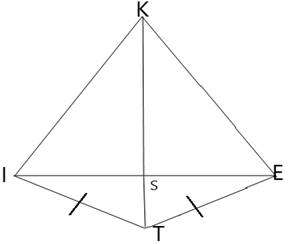
Two disjoints pairs of consecutive sides are congruent.
b.
To find: The statement opposite sides of a kite KITEare parallel is true.
b.
Answer to Problem 2PSA
The statement opposite sides are parallel is false.
Explanation of Solution
Given information:
A KITE with sides KI, IT, TE and KE.
Diagonals of kite KITEare KT and IE.
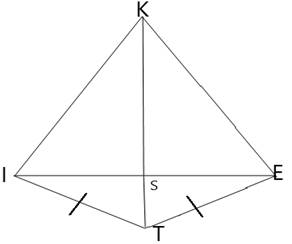
A kite has got two pairs of sides next to each other that have equal length but none of the sides are parallel.
c.
To find:The statement diagonals KTand IE of a kite KITE bisect the
c.
Answer to Problem 2PSA
The statement diagonals KT and IEbisect the angles is true.
Explanation of Solution
Given information:
A KITE with sides KI, IT, TE and KE.
Diagonals of kite KITEare KT and IE.
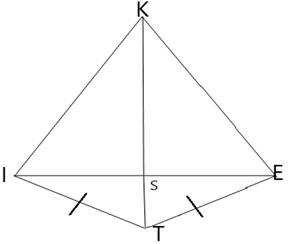
If a quadrilateral is kite, it has one diagonal that bisects a pair of opposite angles.
d.
To find:The statement diagonals KT and IE of a kite KITEbisect each other is true.
d.
Answer to Problem 2PSA
The statement diagonals KTand IE bisect each other is true.
Explanation of Solution
Given information:
A KITE with sides KI, IT, TE and KE.
Diagonals of kite KITEare KT and IE.
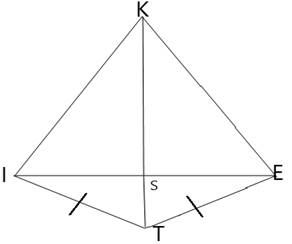
If a quadrilateral is kite, it has one diagonal that bisects the other diagonal.
Diagonals KT and IE bisect each other at point S.
e.
To find:The statement diagonals KT and IE of a kite KITEare congruent is true.
e.
Answer to Problem 2PSA
The statement diagonals KT and IEare congruent is false.
Explanation of Solution
Given information:
A KITE with sides KI, IT, TE and KE.
Diagonals of kite KITEare KT and IE.
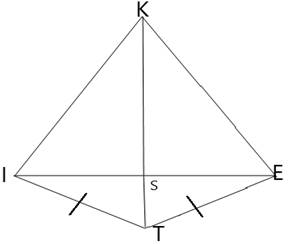
The consecutive sides are congruent but the diagonals are not congruent.
Diagonals KT and IEare not congruent.
f.
To find:The statement diagonals KT and IE of a kite KITE are perpendicular is true.
f.
Answer to Problem 2PSA
The statement diagonals KT and IE are perpendicular is true.
Explanation of Solution
Given information:
A KITE with sides KI, IT, TE and KE.
Diagonals of kite KITEare KT and IE.
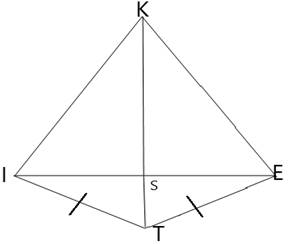
The intersection of the diagonals of a kite form right angles. This means that they are perpendicular. The longer diagonal of a kite bisects the shorter one. This means that the longer diagonal cuts the shorter one in half.
Chapter 5 Solutions
Geometry For Enjoyment And Challenge
Additional Math Textbook Solutions
A First Course in Probability (10th Edition)
Introductory Statistics
Calculus: Early Transcendentals (2nd Edition)
College Algebra (7th Edition)
Thinking Mathematically (6th Edition)
- 5:00 PM Sat May 3 deltamath.com DeltaMath Given: ABBC and D is the midpoint of AC. Prove: ABD ≈ ACBD. ← Back to Home Deltamath Regents Review Week 3 Due: May 9 at 8:00 PM Grade: 97% Step Statement AB ≈ BC Reason 1 Given D is the midpoint of AC 2 BD BD 3 ADDC Calculating Volume (Mixed) Volume of Oblique Solids Volume, Density, and Unit 5 4 AABC is an isosceles triangle ZAZC Conversions (Level 1) Triangle Congruence Criteria try ZAD =/ DC Basic Triangle Proofs (Congruence Only - No CPCTC) Triangle Proofs (Reasons Only) Calculator Aseret Martinez Domi... Log Out Reflexive Property A midpoint divides a segment into two congruent segments The triangle has two congruent sides In a triangle, angles opposite of congruent sides are congruent An angle bisector divides an angle into two congruent angles B * A Ꭰ Note: the segment AC is a straight segment. 86%arrow_forwardLANDMARKS Stonehenge is a British landmark made of huge stones arranged in a circular pattern that reflects the movements of Earth and the moon. The diagram shows that the angle formed by the north/south axis and the line aligned from the station stone to the northmost moonrise position measures 23.5°. a. Find measure of arc BC. b. Is arc ABC semicircle? Explain. c. If the circle measures about 100 feet across, approximately how far would you walk around the circle from point B to point sarsen circle B station stone trilithons horseshoe 71° 23.5° farthest north moonrise Sarrow_forwardfind the value of each variablearrow_forward
- Name: Date: Bell: Unit 11: Volume & Surface Area Homework 2: Area of Sectors Directions: Find the area of each shaded sector. Round to the hundredths place. 1. GH 11 in 2. KL 20 ft H F 64 G L 119 M K 3. BA 6.5 cm 4. YZ 14.2 m B 23 X 87° Y Z 5. KL = 27.1 mm J 32 L X:360-32.1 K A-3 360 7. BD 18 cm E 136 B X=32.8 127.0 (271) A: 069.13 Amm² 19=2102.13 A-136 360.16912 A:300cm² A=96.13 6. PQ = 2.8 in P R 311° 8. WZ 5.3 km V = Z 108 W D 9. HK = 25 ft G H KO 26 X 10. SR 26 m = S 73 T R Gina Wilson (All Things Algebarrow_forward538 Chapter 13 12. Given: Points E(-4, 1), F(2, 3), G(4, 9), and H(-2, 7) a. Show that EFGH is a rhombus. b. Use slopes to verify that the diagonals are perpendicular. 13. Given: Points R(-4, 5), S(-1, 9), T(7, 3) and U(4, -1) a. Show that RSTU is a rectangle. b. Use the distance formula to verify that the diagonals are congruent. 14. Given: Points N(-1, -5), O(0, 0), P(3, 2), and 2(8, 1) a. Show that NOPQ is an isosceles trapezoid. b. Show that the diagonals are congruent. Decide what special type of quadrilateral HIJK is. Then prove that your answer is correct. 15. H(0, 0) 16. H(0, 1) 17. H(7, 5) 18. H(-3, -3) I(5, 0) I(2,-3) 1(8, 3) I(-5, -6) J(7, 9) K(1, 9) J(-2, -1) K(-4, 3) J(0, -1) K(-1, 1) J(4, -5) K(6,-2) 19. Point N(3, - 4) lies on the circle x² + y² = 25. What is the slope of the (Hint: Recall Theorem 9-1.) - line that is tangent to the circle at N? 20. Point P(6, 7) lies on the circle (x + 2)² + (y − 1)² = 100. What is the slope of the line that is tangent to the circle at…arrow_forwardCan you cut the 12 glass triangles from a sheet of glass that is 4 feet by 8 feet? If so, how can it be done?arrow_forward
- Can you cut 12 glass triangles from a sheet of glass that is 4 feet by 8 feet? If so, draw a diagram of how it can be done.arrow_forwardIn triangle with sides of lengths a, b and c the angle a lays opposite to a. Prove the following inequality sin a 2√bc C α b a Warrow_forwardFind the values of x, y, and z. Round to the nearest tenth, if necessary. 8, 23arrow_forward
- 11 In the Pharlemina's Favorite quilt pattern below, vega-pxe-frame describe a motion that will take part (a) green to part (b) blue. Part (a) Part (b)arrow_forward5. 156 m/WXY = 59° 63 E 7. B E 101 C mFE = 6. 68° 8. C 17arrow_forward1/6/25, 3:55 PM Question: 14 Similar right triangles EFG and HIJ are shown. re of 120 √65 adjacent E hypotenuse adjaca H hypotenuse Item Bank | DnA Er:nollesup .es/prist Sisupe ed 12um jerit out i al F 4 G I oppe J 18009 90 ODPO ysma brs & eaus ps sd jon yem What is the value of tan J? ed on yem O broppo 4 ○ A. √65 Qx oppoEF Adj art saused taupe ed for yem 4 ○ B. √65 29 asipnisht riod 916 zelprisht rad √65 4 O ○ C. 4 √65 O D. VIS 9 OD elimiz 916 aelonsider saused supsarrow_forward
 Elementary Geometry For College Students, 7eGeometryISBN:9781337614085Author:Alexander, Daniel C.; Koeberlein, Geralyn M.Publisher:Cengage,
Elementary Geometry For College Students, 7eGeometryISBN:9781337614085Author:Alexander, Daniel C.; Koeberlein, Geralyn M.Publisher:Cengage, Elementary Geometry for College StudentsGeometryISBN:9781285195698Author:Daniel C. Alexander, Geralyn M. KoeberleinPublisher:Cengage Learning
Elementary Geometry for College StudentsGeometryISBN:9781285195698Author:Daniel C. Alexander, Geralyn M. KoeberleinPublisher:Cengage Learning

